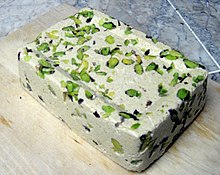Chaloe
bellaria
(Redirectum de Caloe)
Chaloe[1] seu caloe[2] (conversio vocabuli Arabici حلاوة ḥālwa) est categoria bellariorum in arte coquinaria Asiae occidentalis Africaeque boreo-orientalis necnon Europae orientalis, sed praesertim Arabum mediaevalium.


Notae
recensere- ↑ "Chaloe": Tacuinum (p. 87 editionis 1531 apud Google Books)
- ↑ "Caloe": Iamboninus
Bibliographia
recensere- Opera antiquiora
- saec. XIII exeunte : Iamboninus Cremonensis, Liber de ferculis et condimentis no. 10 (Anna Martellotti, Il Liber de ferculis di Giambonino da Cremona [Fasano: Schena, 2001] pp. 88, 253-255) ("Caloe siccum zuccarinum")
- saec. XIV : Kanz al-fawāʾid fī tanwīʿ al-mawāʾid (Nawal Nasrallah, interpr., Treasure Trove of Benefits and Variety at the Table [Lugduni Batavorum: Brill, 2018] p. 229) ("ḥalwā wardiyya")
- c. 1500 : Nimmatnama-i-Nasiruddin-Shahi(en) (Norah M. Titley, ed. et interpr., The Ni'matnama Manuscript of the Sultans of Mandu: The Sultan's Book of Delights [Londinii: Routledge, 2004] p. 58, cf. 77)
- 1531 : Tacuini sanitatis Elluchasem Elimithar; Albengnefit De virtutibus medicinarum et ciborum; Iac. Alkindus De rerum gradibus, Argentorati: apud Ioannem Schottum, 1531 (p. 87 apud Google Books) ("Chaloe cum nucibus" etc.)
- c. 1590 : Abū al-Faḍl al-Mubārak, Āīn-i-Akbarī (H. Blochmann, H. S. Jarrett, interprr., The Aín i Akbari by Abul Fazl Allámi [Calcuttae: Asiatic Society, 1873-1894] vol. 1 p. 59)
- 1911 : Robert H. Christie, Banquets of the Nations: eighty-six dinners characteristic and typical each of its own country (Edinburgi: Gray) pp. 243, 260, 274, 289, 298, 306, 319, 327, 377, 489, 612 ("Hulluah, Hulua, Alluwa, Halva, Halva sohan, Kaddu halva, Badam a halva, Boat-ka-hulva, Stafithi helvah")